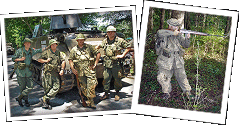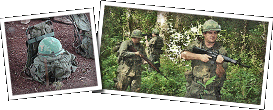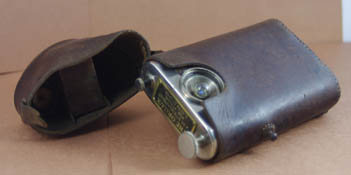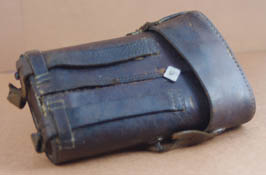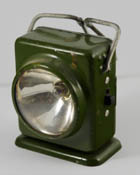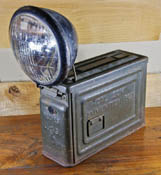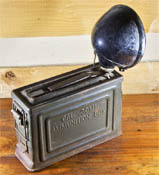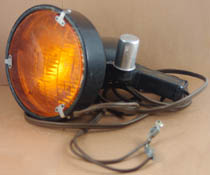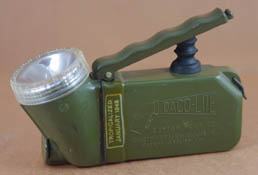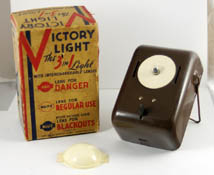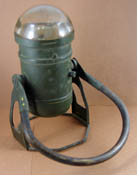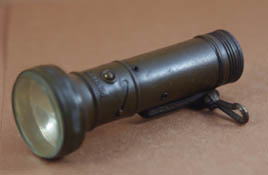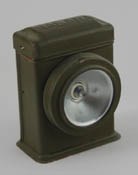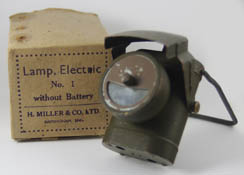Flashlights from 1917 to 2000
From WW1 thru the end of the 20th Century, there has been quite a change in the ability for soldiers to be able to work at night. During the last major US war, candles, matches & torches were the norm. As technology advanced, flashlights became more rugged, smaller, and more specific to their intended function. This is not meant as a complete list of all flashlights used by American soldiers, but rather a sampling of them.
WW1 - 1939
WW2
TL-122 Series Flashlights
The TL-122 Series was the most common Flashlight for the GI in WW1.From Left to Right are the TL-122A (in use before WW2), TL-122B (issued Sept 1943), TL-122C (issued April 1944), and TL-122D (issued late 1944). The TL-122A had a brass body & the TL-122B thru TL-122D were made from plastic. The last version, the TL-122D has provisions for colored lens storage in the base. I do not know if the 2nd lens ring is original on TL-122D flashlights... the plastic matches, so it may be. For more info on WW2 flashlights visit Olive-Drab.com's flashlight page |
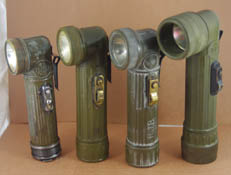
|
| Original box of 20 replacement lenses for the TL-122A |
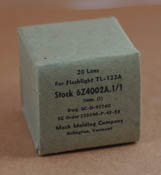
|
| Original Upgrade kit to add spare lens storage & lens ring to earlier model flashlights. (There are no markings on the box, and the rings match both the cap/ring on my MX-991/U and TL-122D flashlights, so I can not properly ID it's age. |
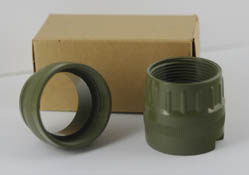
|
"Experimental" FlashlightThis seems to be a copy of a TL-122 series flashlight using the Ethocel (transparent plastic) seen in experimental canteens made from 1942-1944. |

|
English Made TL-122DEnglish Made TL-122D with filter container in base. (no extra lens ring on my example) Stampings on bottom: FILTER CONTAINTER Stamp at neck of flashlight: 6230-264-8261 |
 > >
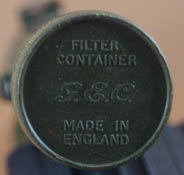
|
TL-122 Lens HoodLens Hood for a TL-122 Flashlight from the Minefield Marking Set, Set No. 2 |
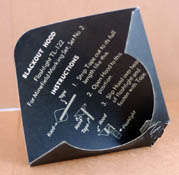
|
Other WW2 Flashlights
Post-WW2
MX-991\U and similar Flashlights
The MX-991\U is the post WW2 replacement for the TL-122 series of flashlights. The "/U" in the name stands for "Underwater"...aka waterproofed. To the right is a comparison of three MX-991\U flashlights. From left to right: Note: this Fulton (and the early Fulton below) do not have the hole in the belt clip that the G.T. Price & Brightstar have. Note: G.T. Price also stamps "U.S." above the model number. Fulton, USALite, and Brightstar do not stamp the "U.S." For more info on MX-991/U flashlights visit Olive-Drab.com's flashlight page
|

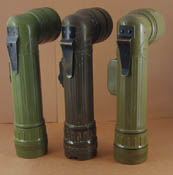 |
MX-991\U, Fulton Brand, without switchguards, 1981 contract, produced in 1982. |
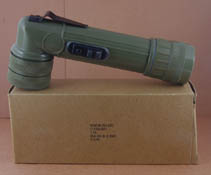 |
| MX-991\U, Fulton Brand, with a light-stick/reflector lens attachment |
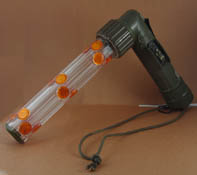 |
| TL-124 2-AA cell flashlight compared to a standard MX-991\U. |
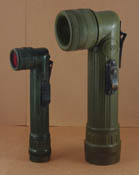 |
Yellow/Black Fulton MX-212/U, Yellow Fulton MX-992/U, Red USALite MX 212/U Explosion Proof Flashlights. The photo of the lens shows the wire keeper for the bulb. The keeper serves to stop the bulb shards from penetrating the lens & allowing a spark to ignite in explosive gas environments. |

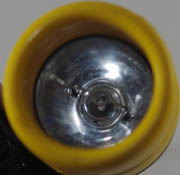 |
G.T. Price MX-993/U 2-cell and MX-994/U 3-cell flashlights.
|
 |
| Unissued Fulton MX-993/U with traffic/signal cone attachment |
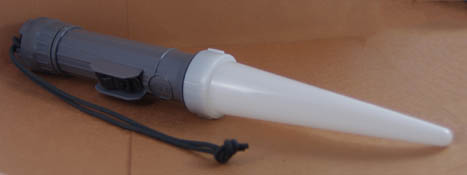 |
Navy/Army Life Jacket / Marker flashlights. All three have metal clips for attaching ot uniform/gear. From left to right: USN light made by BMG Tan light made by Fulton No. D-31grey light with IR lens made by G.T. Price |
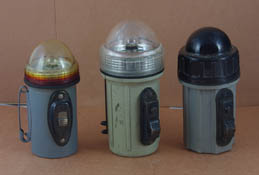 |
Various Post WW2 Flashlights
Four U.S. Air Force PenlightsTop: Flashlight, Penlight Style, Pilots. Black lens bezel rotates for Red or White light. 2nd from top: Unmarked Penlight Bottom two: Green & Yellow 1952 Pen Flashlights made by Justrite Manufacturing Co. |
 |
U.S. Navy, U.S., and U.S.A.F explosion proof flashlights. These have the same lamp keeper that the MX-991\U based flashlights have. |
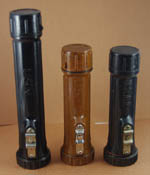 |
Navy Battle Lantern, Manufactured by The Roflan Company Used for emergency lighting aboard ship. |
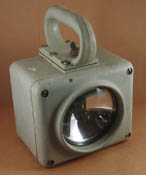
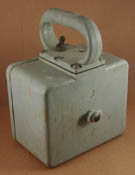 |
| Galvanized Electric Headlamp, Manufactured 1965, Made by G.T. Price Products. |
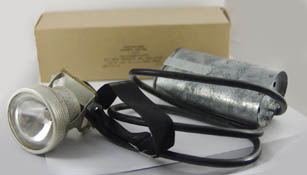 |
| U.S. Navy Headlamp No. 32N, Justrite Manufacturing |
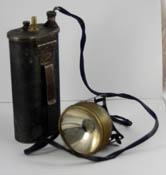 |
| Pivot Head flashlight made by JustRite Manufacturing. note slot on belt clip for hanging lamp on a nail. |

 |
Minefield Marker Lights, Ace Electronics These came with a fiberglass pole to mount the flashlight on. The light is a directional (you can see the shield in the photo) strobe. |
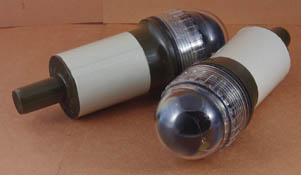 |
Mortar Aiming Lights These are used to illuminate the aiming stakes to allow aiming the mortar at night. The brass lamp (laying down) is probably WW2 vintage. The lamp standing up (missing angled light shroud) is plastic & probably 1980's vintage. |
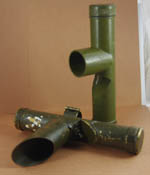 |
Brightstar model 451 flashlight with bore/inspection lamp. Additional Info from Fred Newcomb: It was issued to Army Aircraft Mechanics as an inspection light. As far as I can remember, it came in the A-90 AVUM tool set (aviation unit tool room). |
 |
Light, Marker, Distress The Marker case could be laced over a harness strap, or sometimes seen sewn to a canteen cover or Load Bearing Vest.
Note: If you're looking to power one of these Distress Markers using easily obtainable CR123 batteries, visit PRC68.com |
|
Light, Marker, Distress This Distress Marker was powered using two AA batteries. It has velcro on the front, a snap clip on the back, and a lanyard for securing the marker. |
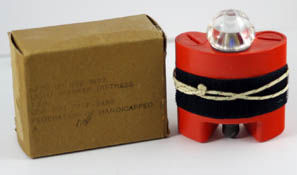
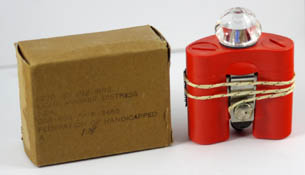 |
Flashlight, NSN 6230-0. Contract date 1991. Manufactured by Overseas Contractors Supplies (OCS). Also known as a mini-lantern. Metal clip & velcro on the back for attachment. The red lens slides up/down. Thanks to Johnny M. Lanctot the following information about this flashlight:
From Fred Newcomb:
Also, thanks to Eric Gustafsson for directing me to the NSN/contract info listed above.
|
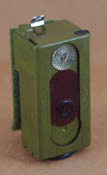
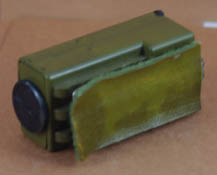 |
| This is a Infrared Strobe that attaches to the top of a 9 volt battery. These are used for IFF (Identification, Friend or Foe). The Infrared Strobe is not visable to the naked eye, but looks like a flashing strobe when viewed through night vision goggles. |
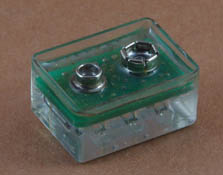
 |
Batteries
Boy Scout Flashlight
Comparison between Boy Scout & TL-122A flashlightsWhile not a military flashlight, I've included the BSA flashlight to show how similar it is to a TL-122A flashlight. |
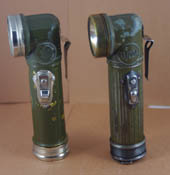 |
Boy Scout FlashlightsLeft:USALITE Right: BRIGHT STAR INDUSTRIES |



|
